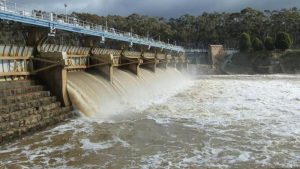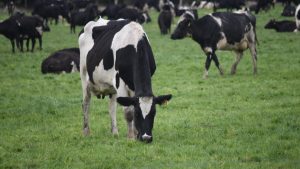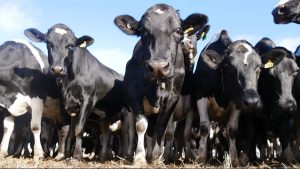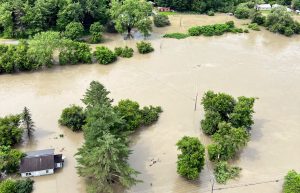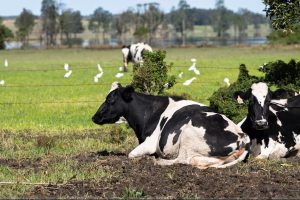
As rain continues to the batter the north coast and flood water ravages the region, primary producers are frantically shifting livestock to higher ground.
It comes after drought, bushfires and for some it’s the second time in two years where farmers have needed to wade cattle through floodwaters to safety.
Dairy farmers at Tuncester, NSW, near Lismore swam to safety but have lost cattle, equipment and newly harvested silage in the flood event that went far above benchmark indicators.
Paul Weir said milking cows had been brought up to the apparent safety of the dairy but during the early hours of Monday morning, levels rose more than 1.7 metres above the record height set in 1974.
Hundreds of cattle have gone; some spotted swimming in South Lismore, others reaching relative safety of hill country near Tuncester but many more whose whereabouts are not known.
A lucky harvest of silage, 550 tonnes of sorghum round-baled and wrapped in plastic, was cut between showers two weeks ago but is now all gone – floated away.

Mr Weir’s son Matthew swam from the house to the shed to retrieve his jet ski and after rescuing his two brothers and friends off the rooves of their homes, set off to help the citizens of South Lismore.
To keep the operation going they have had to siphon unleaded fuel from cars and quad bikes stranded on the farm and he it is continuing to respond to calls for help from residents stuck in their flooded homes.
Mr Weir said feed brought to higher ground in anticipation of the rain event would only provide feed for a short time, as many more head had found the raised ground from neighbouring farms.
At Mogul Brahman Stud, Stratheden south of Casino, a new record flood height for Shannon Creek coming on top of near record flows last week, has isolated the property with water under the house through vehicles and some paddocks 1.5m deep.
There remains the real potential for losses of commercial cows with calves, said manager Glen Pfeffer, who has had to evacuate the property, throwing open all gates before he left.
Meanwhile show bulls are standing in water 450mm deep – not quite as much as has fallen during the course of this rain event.
Unprecedented rain falling in the complex upper catchments of the Richmond and Wilsons rivers have already far exceeded record heights set in 1974 – by nearly 2m at Lismore – with water levels continuing to rise.
Now producers on the lower river are bracing for their greatest inundation ever – exceeding even the 1954 event,
The 2022 flood is expected to top the 1954 record in the Wilsons River but has yet to peak in the lower Richmond River catchment with maximum levels expected on the high tide Tuesday morning.
Livestock carrier Margaret Clark, Casino, said cattle producers who are veterans of flood jumped early and moved stock to higher ground, but so much water was moving through the back swamps south and west of Coraki and Woodburn that the likelihood of a major lower river event was locked-in.
“There is so much water coming down through Rappville, Leeville, Shannonbrook, Bungawalbyn Rocky Creek,” she said.
“That’s the problem – the amount of back water and that’s not counting the flood coming down from Lismore.”
At Kilgin, downriver from Woodburn, mixed farmer Tony Carusi is preparing for an inundation greater than the historic 1954 event, which was witnessed by his family, and which was marked on timber as a record as bening 380 to 450mm higher than 1974. The Tuesday morning flood is expected to go higher.
“We’ve already lifted equipment but we can’t go any higher because of our logistical capability. We would need more pallets. We’re even scraping around for empty fuel drums so we can lift furniture and couches.”
Macadamia farmers in the Northern Rivers are bracing for significant damage.
NSW Farmers Lismore Branch Chair and macadamia farmer Warren Elvery said there would be major losses as a result of the flooding, which was the worst he had ever seen.
“There are going to be big losses in the industry in terms of quality and quantity,” Mr Elvery said. “We had 347mm of rain overnight and all of the work we’ve done building up our soil and getting ready for harvest could all be for nothing.”
Further south at Kempsey and those along the Manning River, it’s déjà vu for producers who this time last year were hit by a major flood. Many on low-lying properties have shifted cattle or are moving them to higher ground as the weather system moves south.
NSW Farmers vice president Xavier Martin said: “our thoughts are with those colleagues in the northern valleys in this extreme event who have already been through drought and fires and are now facing with what’s becoming a once in a 100 year event.”








